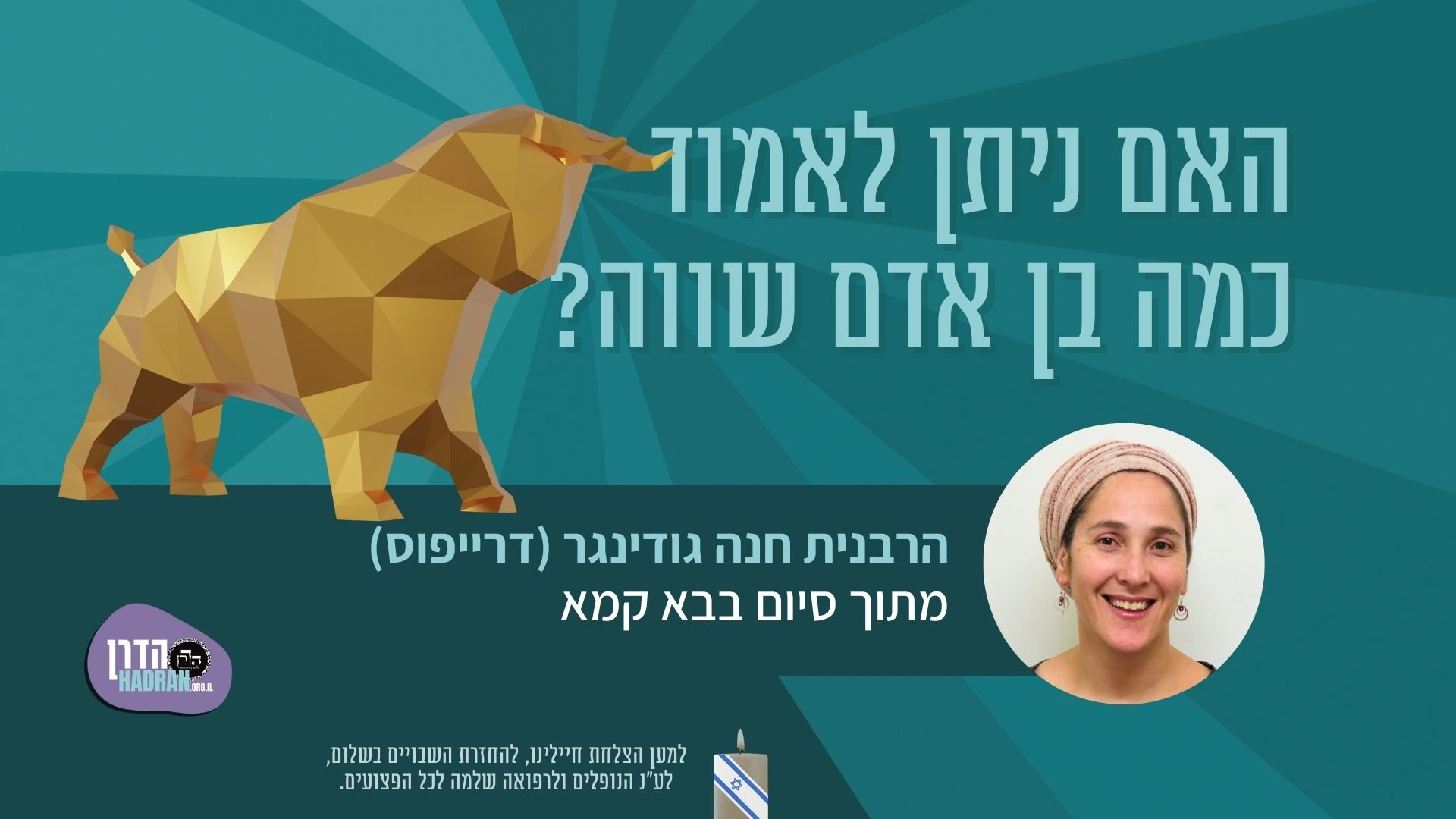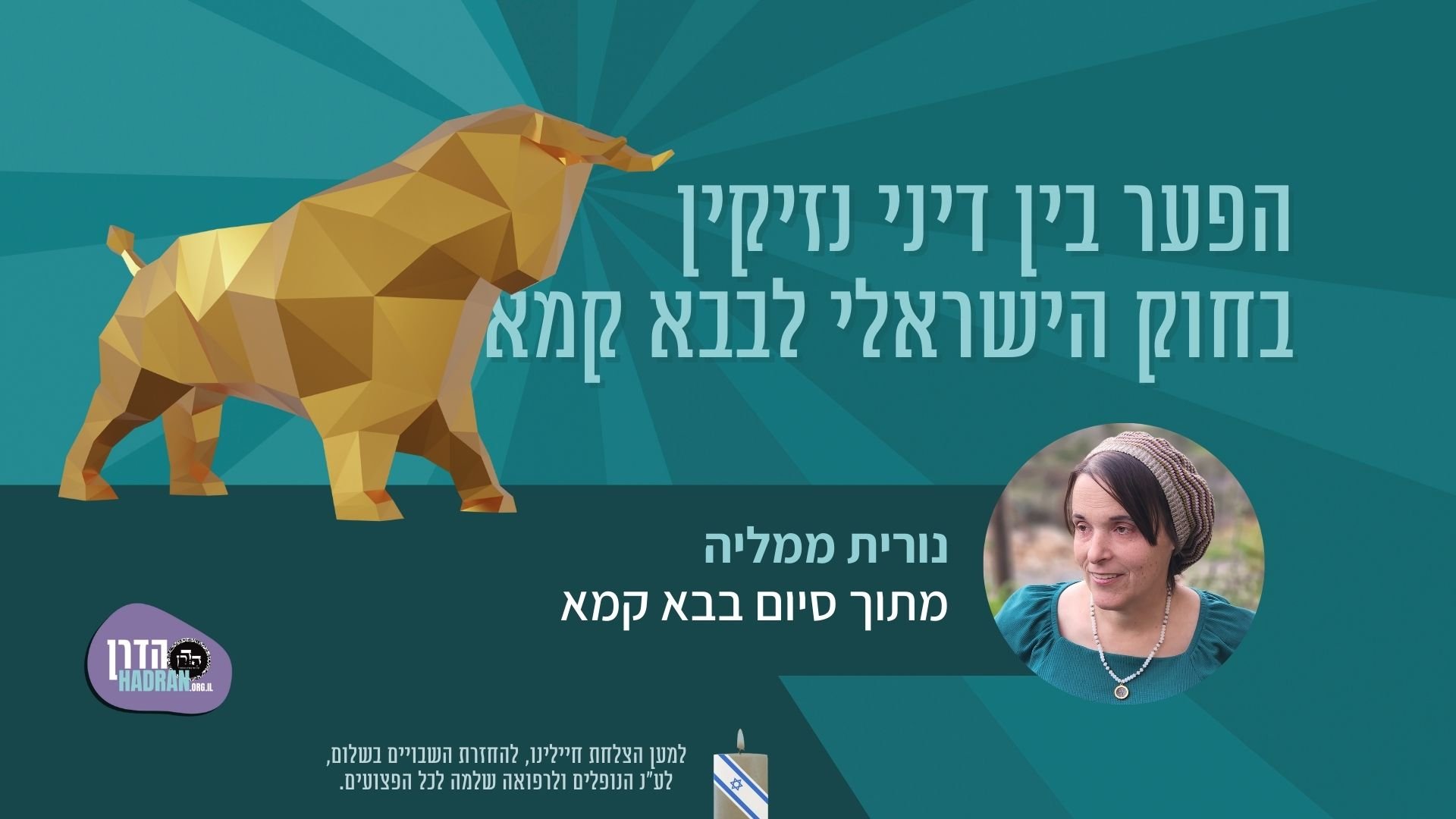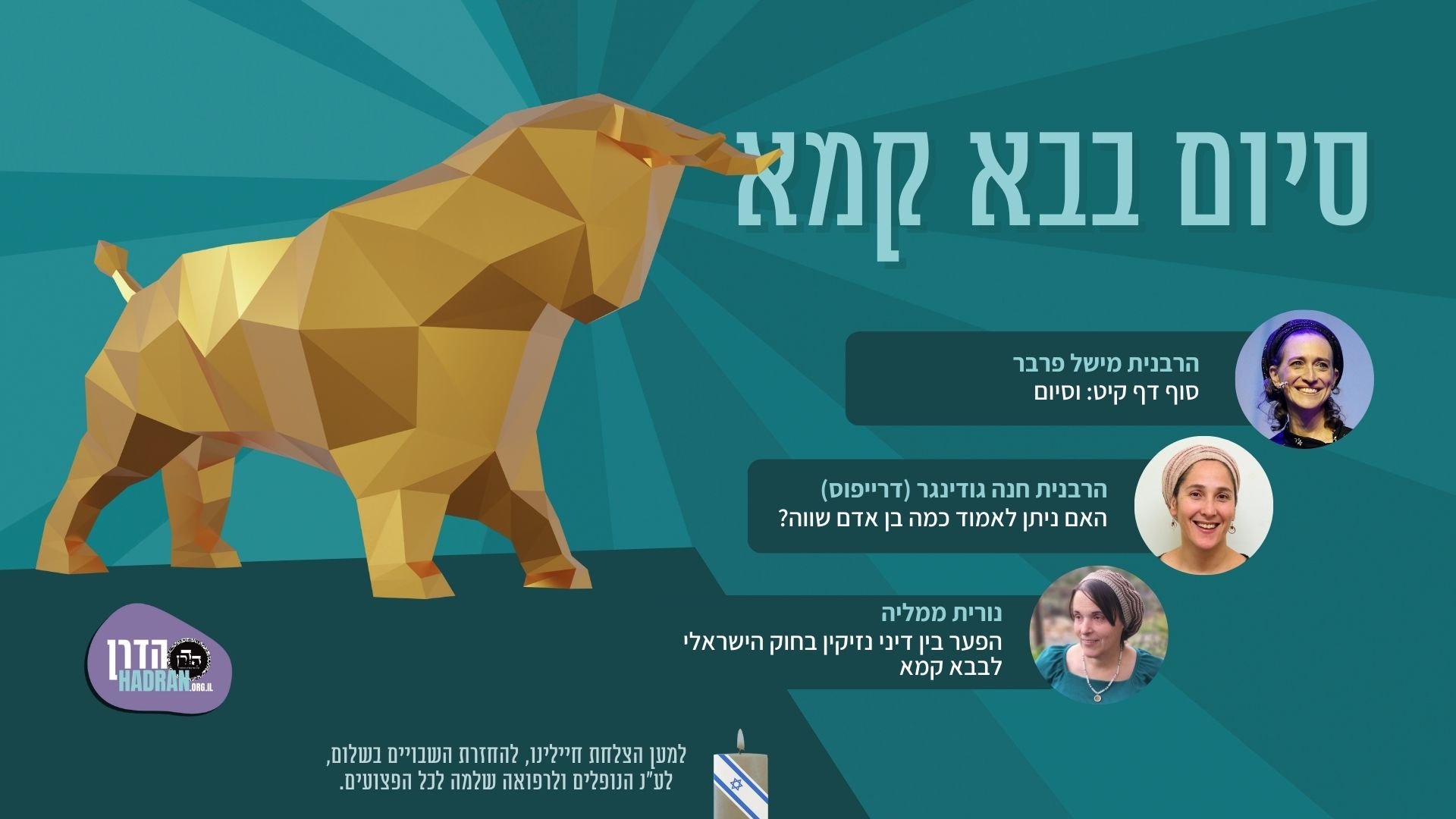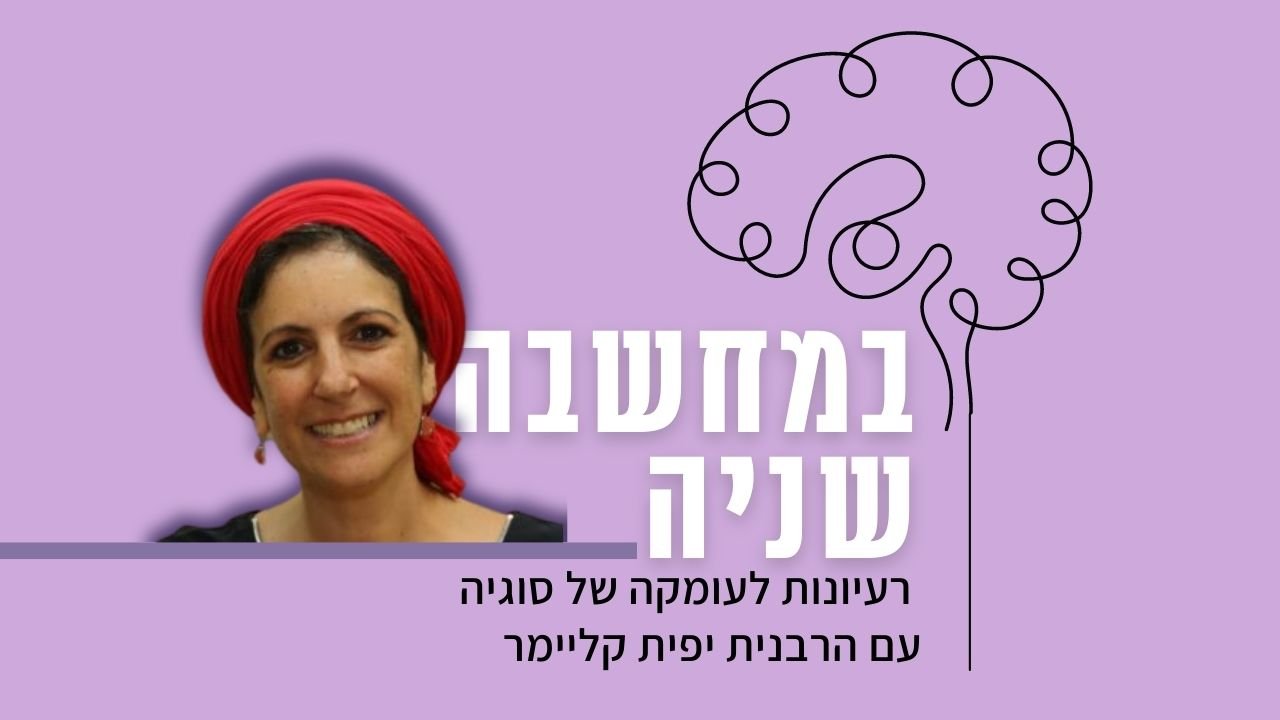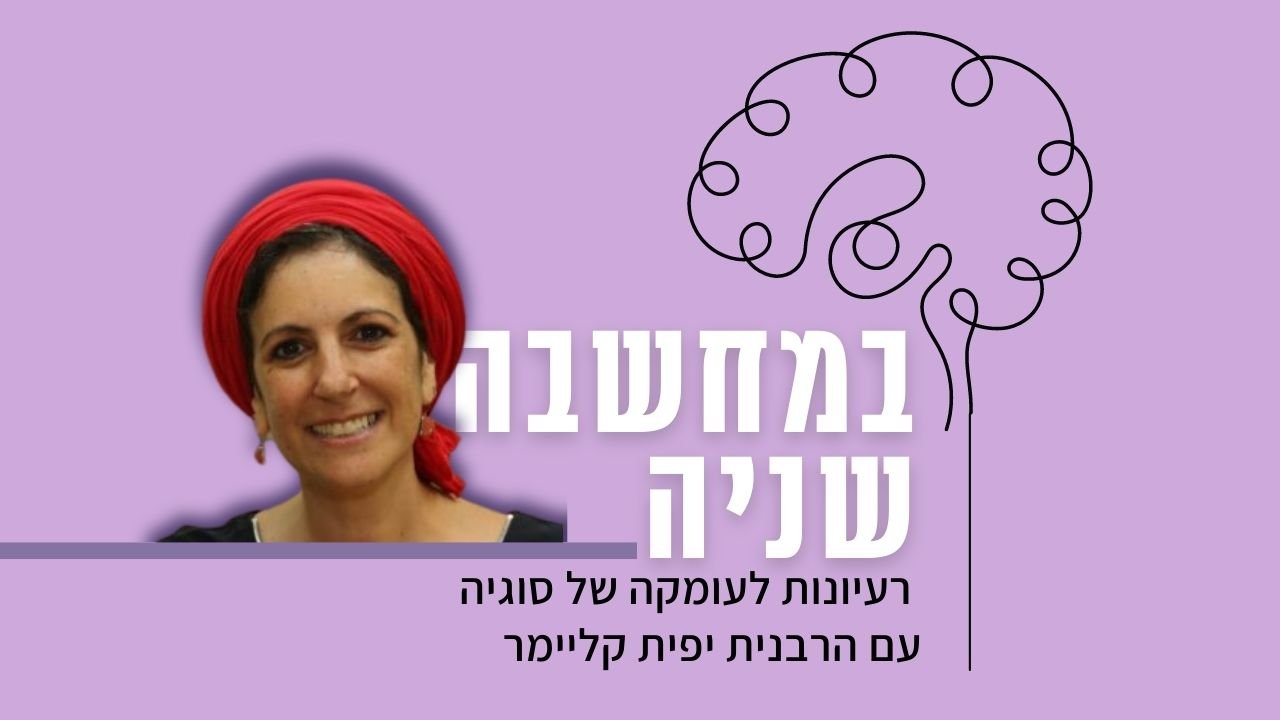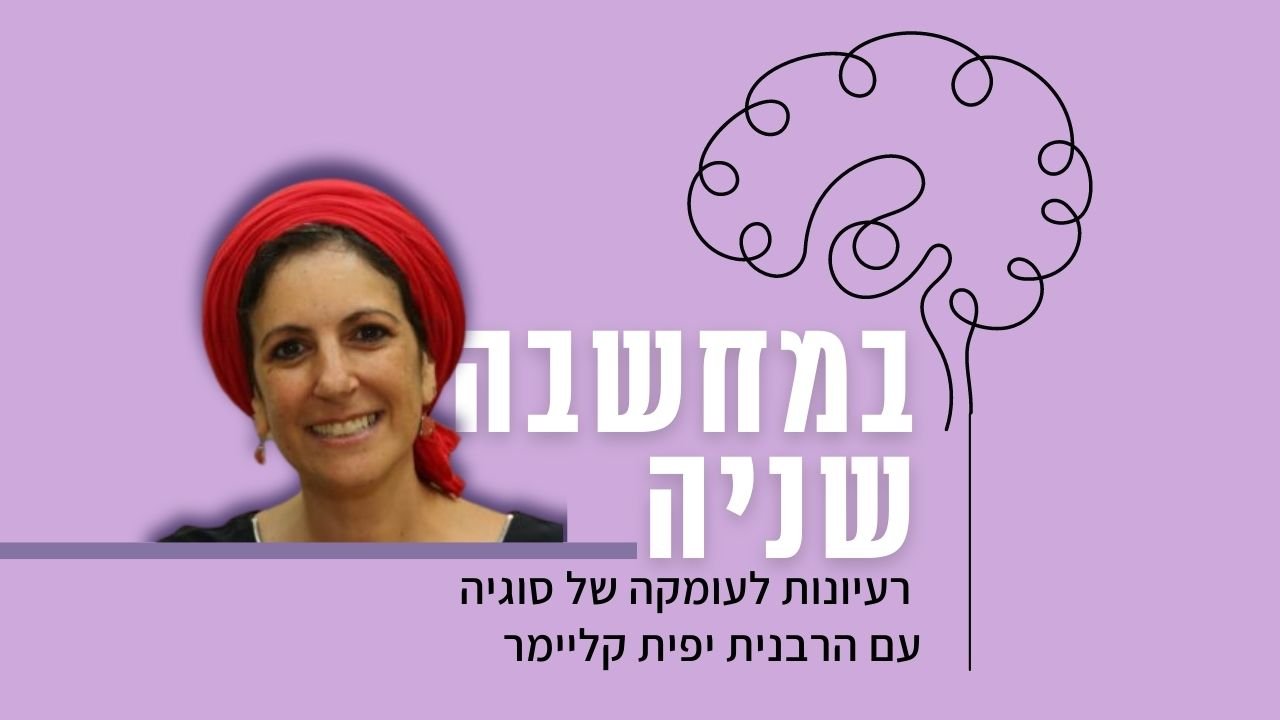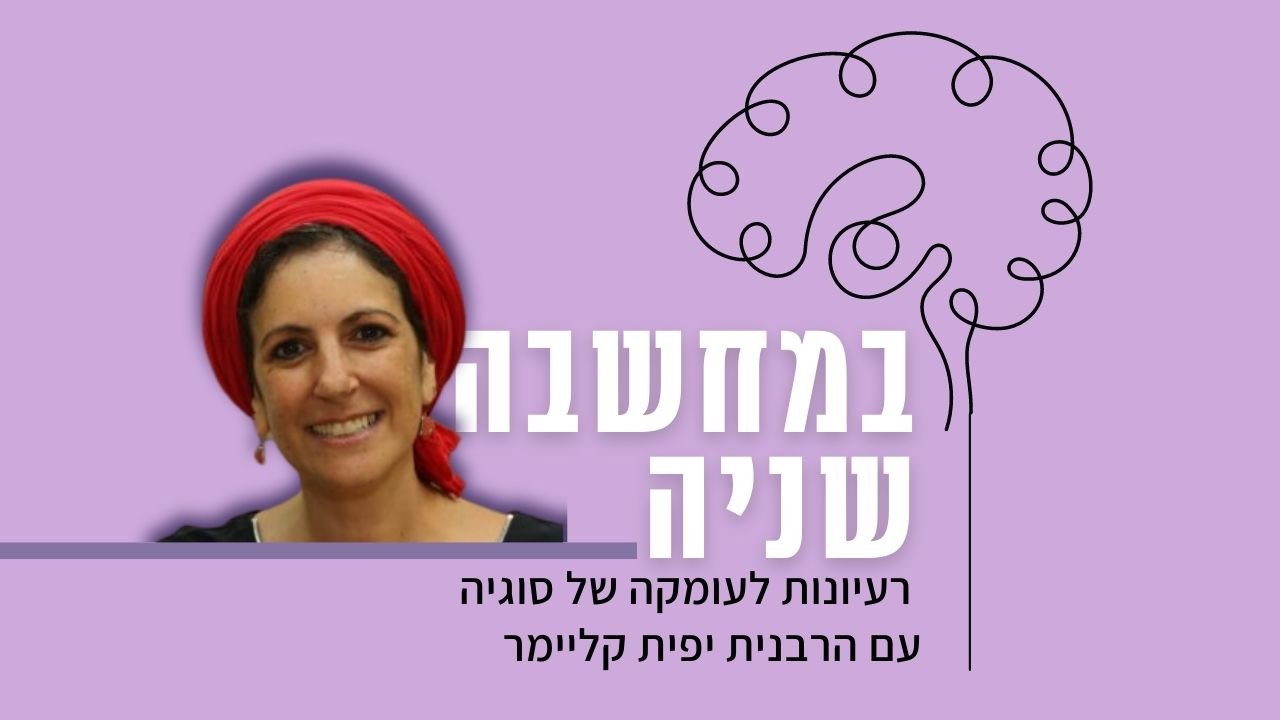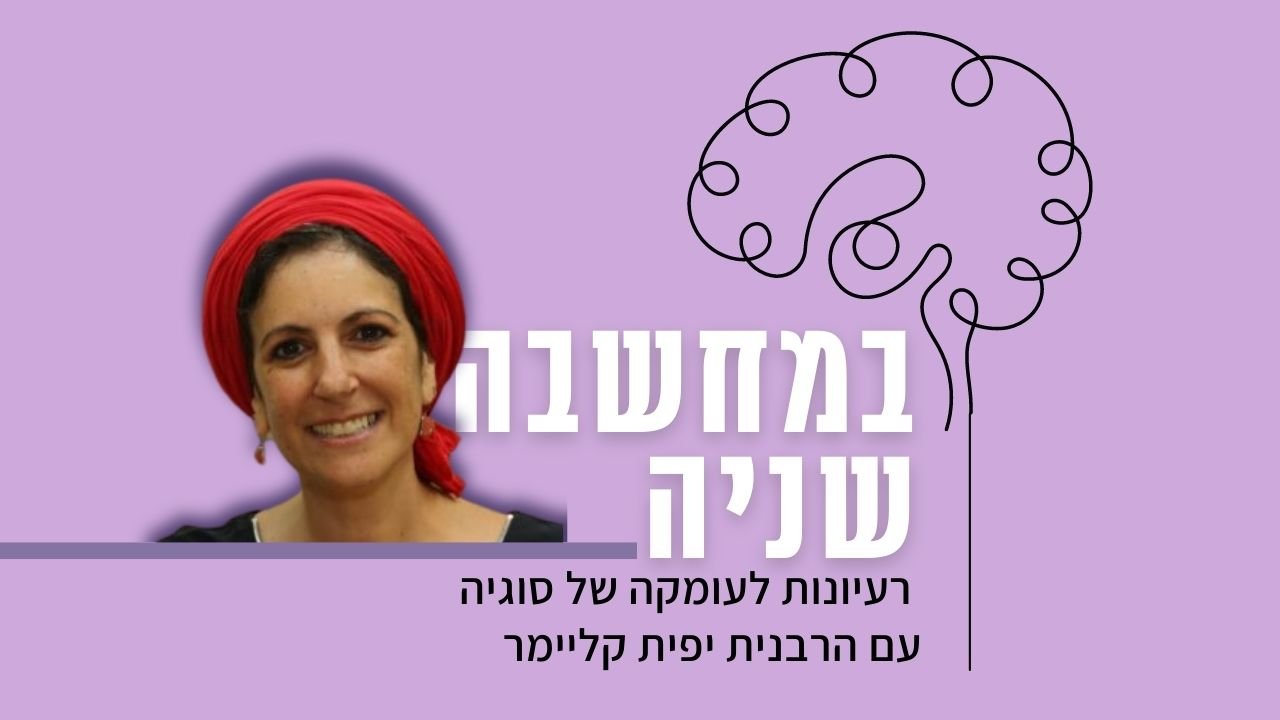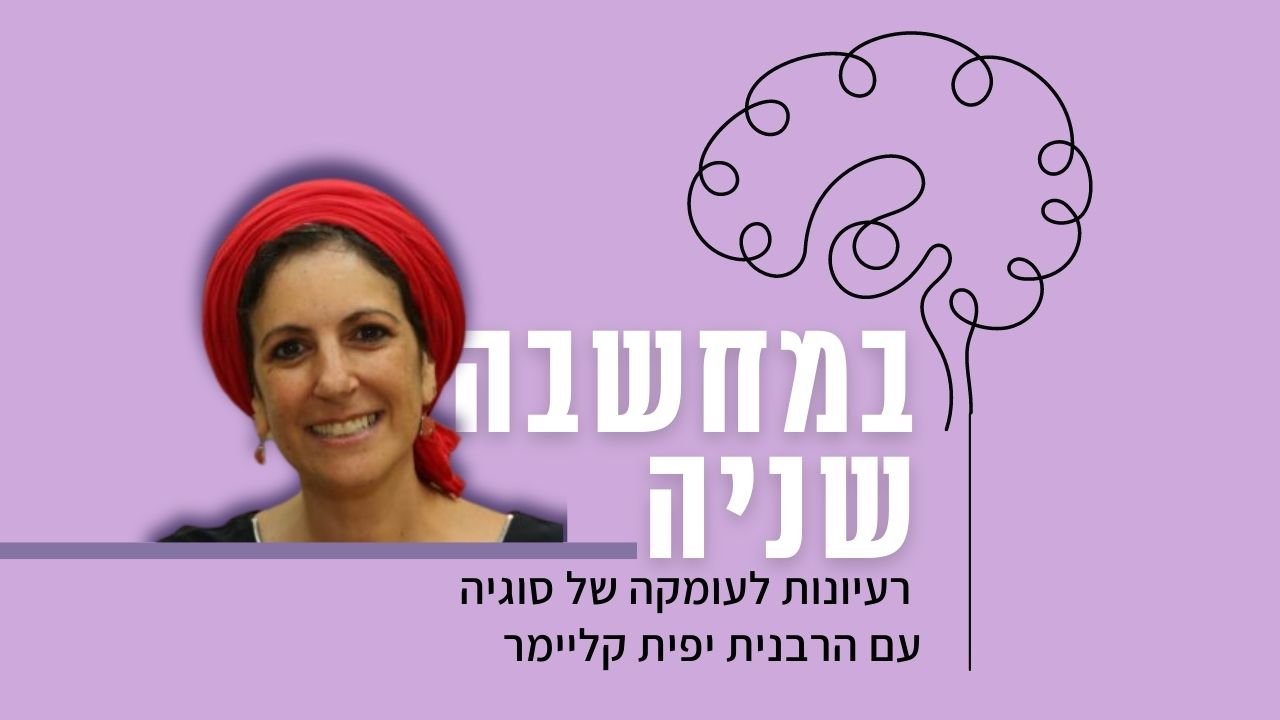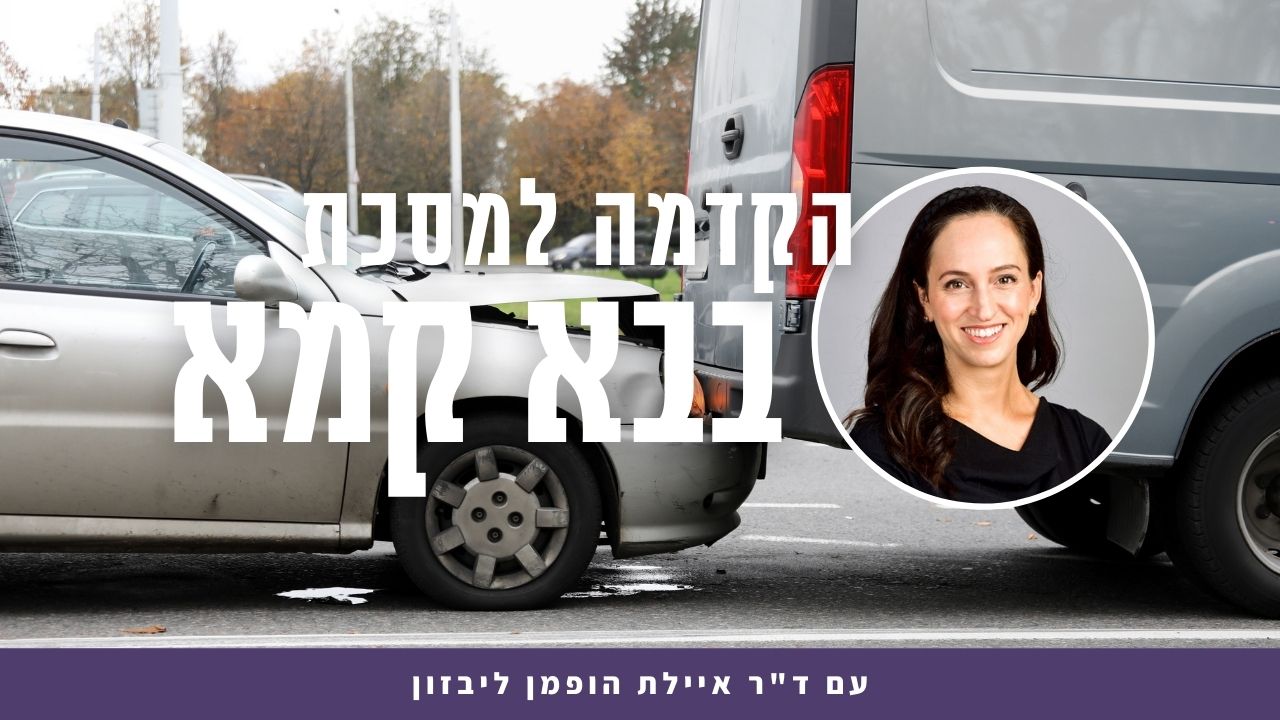יש מחלוקת בין רב נחמן לאמוראים אחרים האם עבדים נחשבים כקרקע או כמטלטלין. הגמרא מציעה שאולי זה גם מחלקות בין תנאים אבל ההצעה נדחתה. אפילו אם נגיד שעבדים כמטלטלין או כקרקעות, איך עבדים שונים מהם? במשנה כתוב שנכסים שאין בהם מעילה חייבים על נזקיהם. מניסוח זה משמע שכלול בתוך חיוב נזיקין קדשים קלים – ז”א שהמשנה כשיטת ר’ יוסי הגלילי הסובר שקדשי קדשים ממון בעלים. הגמרא מביאה סתירה בין דבריו לבין משנה ופותרת בשתי דרכים שונות. הגמרא מביאה קושי על הפתרון השני.
הלימוד השבוע מוקדש ע”י רוברט ופאולה כהן לע”נ יוסף בן משה הכהן ז”ל. יוסף היה חזן שאהב מאוד לשיר, עבד קשה בחייו והיה מאוד מסור למשפחתו ולקהילה.
רוצה להקדיש שיעור?

כלים
הלימוד השבוע מוקדש ע”י רוברט ופאולה כהן לע”נ יוסף בן משה הכהן ז”ל. יוסף היה חזן שאהב מאוד לשיר, עבד קשה בחייו והיה מאוד מסור למשפחתו ולקהילה.
כלים
העמקה
רוצה להבין מה באמת קורה מתחת לפני השטח של הסוגיה?
שיעורים, פודקאסטים והרחבות של מיטב המורות שלנו יפתחו לך עוד זוויות וכיווני חשיבה.
חדשה בלימוד הגמרא?
זה הדף הראשון שלך? איזו התרגשות עצומה! יש לנו בדיוק את התכנים והכלים שיעזרו לך לעשות את הצעדים הראשונים ללמידה בקצב וברמה שלך, כך תוכלי להרגיש בנוח גם בתוך הסוגיות המורכבות ומאתגרות.
פסיפס הלומדות שלנו
גלי את קהילת הלומדות שלנו, מגוון נשים, רקעים וסיפורים. כולן חלק מתנועה ומסע מרגש ועוצמתי.
בבא קמא יב
לְבָתַר דִּנְפַק, אֲמַר לְהוּ עוּלָּא, הָכִי אָמַר רַבִּי אֶלְעָזָר: אֲפִילּוּ מִיַּתְמֵי. אָמַר רַב נַחְמָן: אִשְׁתְּמִיטַן עוּלָּא.
The Gemara relates: After Rav Naḥman exited the study hall, Ulla said to the remaining Sages in the study hall: In truth, this is what Rabbi Elazar said: A slave can be collected as payment even when collecting from the debtor’s orphans. Generally, when collecting a debt from the debtor’s orphans the creditor can collect only from the land that they inherited from their father, which is liened to the debt. Rabbi Elazar rules that a creditor can also collect from the slaves they inherited, as he holds that in this regard, the legal status of slaves is like that of land. Ulla did not reveal this fact to Rav Naḥman, as he knew that Rav Naḥman disagreed and held that the legal status of slaves is like that of movable property. When he heard of Ulla’s revelation, Rav Naḥman said: Ulla evaded me, as had he told me Rabbi Elazar’s full opinion, I would have brought proofs against his opinion.
הֲוָה עוֹבָדָא בִּנְהַרְדְּעָא, וְאַגְבּוֹ דַּיָּינֵי דִנְהַרְדְּעָא. הֲוָה עוֹבָדָא בְּפוּמְבְּדִיתָא, וְאַגְבְּיֵהּ רַב חָנָא בַּר בִּיזְנָא. אֲמַר לְהוּ רַב נַחְמָן: זִילוּ אַהֲדוּרוּ, וְאִי לָא – מַגְבִּינַן לְכוּ לְאַפַּדְנַיְיכוּ.
The Gemara relates: There was an incident in Neharde’a, and the judges of Neharde’a collected, on behalf of a creditor, slaves that orphans had inherited from the debtor. There was an incident in Pumbedita, and Rav Ḥana bar Bizna collected slaves from orphans as repayment for a debt. Rav Naḥman said to those judges: Go and return those slaves to the orphans, and if you do not do so, we will collect the value of the slaves from the proceeds of your own mansions in order to compensate the orphans for their loss, as you have made an elementary mistake in your ruling and therefore you are responsible to rectify it.
אֲמַר לֵיהּ רָבָא לְרַב נַחְמָן: הָא עוּלָּא, הָא רַבִּי אֶלְעָזָר, הָא דַּיָּינֵי דִנְהַרְדְּעָא וְהָא רַב חָנָא בַּר בִּיזְנָא; מָר – כְּמַאן סְבִירָא לֵיהּ?
Rava said to Rav Naḥman: There is Ulla, there is Rabbi Elazar, there are the judges of Neharde’a, and there is Rav Ḥana bar Bizna, all of whom ruled based on the assumption that the legal status of slaves is like that of land. In accordance with whose opinion does the Master, i.e., you, Rav Naḥman, hold?
אֲמַר לֵיהּ: אֲנָא מַתְנִיתָא יָדַעְנָא – דְּתָנֵי אֲבִימִי: פְּרוֹזְבּוּל חָל עַל הַקַּרְקַע, וְאֵינוֹ חָל עַל הָעֲבָדִים. מִטַּלְטְלִין נִקְנִין עִם הַקַּרְקַע, וְאֵינָן נִקְנִין עִם הָעֲבָדִים.
Rav Naḥman said to him: I know a baraita that supports my opinion, as Avimi teaches: A document that prevents the Sabbatical Year from abrogating an outstanding debt [prosbol] takes effect upon a debt assumed by one who owns land, but a prosbol does not take effect upon a debt assumed by one who owns slaves of the debtor. And movable property is acquired together with the land one acquires through the act of acquisition performed on the land, but movable property cannot be acquired together with the slaves that one acquires. Both halakhot assume that in these cases the legal status of slaves is not like that of land.
לֵימָא כְּתַנָּאֵי –
The Gemara suggests: Let us say that this issue is the subject of a dispute between tanna’im in the following baraitot.
מָכַר לוֹ עֲבָדִים וְקַרְקָעוֹת; הֶחְזִיק בַּעֲבָדִים – לֹא קָנָה קַרְקָעוֹת, בְּקַרְקָעוֹת – לֹא קָנָה עֲבָדִים. קַרְקָעוֹת וּמִטַּלְטְלִין; הֶחְזִיק בְּקַרְקַע – קָנָה מִטַּלְטְלִין, בְּמִטַּלְטְלִין – לֹא קָנָה קַרְקַע. עֲבָדִים וּמִטַּלְטְלִין; הֶחְזִיק בַּעֲבָדִים – לֹא קָנָה מִטַּלְטְלִין, בְּמִטַּלְטְלִין – לֹא קָנָה עֲבָדִים.
One baraita teaches: If one sold slaves and land to a buyer and the buyer took possession of the slaves alone, he does not thereby acquire the land. If he took possession of the land alone, he does not thereby acquire the slaves. If one sold land and movable property to a buyer and the buyer took possession of the land alone, he thereby also acquires the movable property. If he took possession of the movable property alone, he does not thereby acquire the land. If one sold slaves and movable property to a buyer and the buyer took possession of the slaves alone, he does not thereby acquire the movable property. If he took possession of the movable property alone, he does not thereby acquire the slaves.
וְהָתַנְיָא: הֶחְזִיק בַּעֲבָדִים – קָנָה מִטַּלְטְלִין!
But isn’t it taught in another baraita: If the buyer took possession of the slaves alone, he thereby also acquires the movable property? This directly contradicts the ruling in the parallel clause of the previous baraita.
מַאי, לָאו בְּהָא קָמִפַּלְגִי – דְּמָר סָבַר: עֲבָדִים כִּמְקַרְקְעֵי דָּמֵי, וּמָר סָבַר: עֲבָדִים כְּמִטַּלְטְלִין דָּמֵי?
What, is it not the case that it is about this that they disagree, that one Sage, the tanna of the second baraita, holds that the legal status of slaves is like that of land, and the other Sage, the tanna of the first baraita, holds that the legal status of slaves is like that of movable property?
אָמַר רַב אִיקָא בְּרֵיהּ דְּרַב אַמֵּי: דְּכוּלֵּי עָלְמָא – עֲבָדִים כִּמְקַרְקְעֵי דָּמֵי. וְהָדְתַנְיָא קָנָה – שַׁפִּיר; וְהָדְתַנְיָא לֹא קָנָה – בָּעֵינַן קַרְקַע דֻּומְיָא דְּ״עָרִים מְצוּרוֹת בִּיהוּדָה״ – דְּלָא נָיְידִי.
The Gemara rejects this: Rav Ika, son of Rav Ami, said: According to everyone, the legal status of slaves is generally like that of land, and therefore, that which is taught in the second baraita, that by taking possession of the slaves he also acquires the movable property, is properly understood. And that which is taught in the first baraita, that in such a case he does not acquire the movable property, the reason for this ruling is that the tanna of that baraita holds that in order for movable property to be acquired together with land, we require that he acquire land similar to “fortified cities in Judea” (II Chronicles 21:3), which do not move around. Slaves, even if their legal status is generally like that of land, do not fulfill this requirement.
דִּתְנַן: נְכָסִים שֶׁאֵין לָהֶם אַחְרָיוּת נִקְנִין עִם נְכָסִים שֶׁיֵּשׁ לָהֶם אַחְרָיוּת – בְּכֶסֶף, בִּשְׁטָר וּבַחֲזָקָה. מְנָהָנֵי מִילֵּי? אָמַר חִזְקִיָּה, דְּאָמַר קְרָא: ״וַיִּתֵּן לָהֶם אֲבִיהֶם מַתָּנוֹת רַבּוֹת לְכֶסֶף וּלְזָהָב וּלְמִגְדָּנוֹת, עִם עָרֵי מְצֻרוֹת בִּיהוּדָה״.
The reason behind the need for land to be like the “fortified cities in Judea” is that the halakha that one can acquire movable property together with land is derived from this verse, as we learned in a mishna (Kiddushin 26a): Property that does not serve as a guarantee, i.e., movable property, is acquired together with property that does serve as a guarantee, i.e., land, be it through the buyer giving money to the seller, by the seller giving the buyer a bill of sale, or by the buyer performing an act of taking possession. The Gemara asks: From where is this matter derived? Ḥizkiyya said: As the verse states: “And their father gave them great gifts, of silver, and of gold, and of precious things, with fortified cities in Judea” (II Chronicles 21:3). The verse indicates that the acquisition of the movable property was done together with that of the cities of Judea.
אִיכָּא דְּאָמְרִי, אָמַר רַב אִיקָא בְּרֵיהּ דְּרַב אַמֵּי: דְּכוּלֵּי עָלְמָא – עַבְדֵי כְּמִטַּלְטְלִין דָּמֵי. וְהָדְתַנְיָא לֹא קָנָה – שַׁפִּיר; הָא דְּתַנְיָא קָנָה – בְּעוֹדָן עָלָיו.
There are those who say that Rav Ika stated a different answer: Rav Ika, son of Rav Ami, said: According to everyone, the legal status of slaves is generally like that of movable property, and therefore, that which is taught in the first baraita, that by taking possession of the slaves he does not also acquire the movable property, is properly understood. And that which is taught in the second baraita, that in such a case he acquires the movable property, applies to a case in which at the moment the slave was acquired, the movable property was still upon him, e.g., the slave was holding it, and it could therefore be acquired together with the slave. This is because one’s slave is considered like one’s courtyard, and any item that is placed within it is acquired for its owner.
וְכִי עוֹדָן עָלָיו מַאי הָוֵי? חָצֵר מְהַלֶּכֶת הִיא, וְחָצֵר מְהַלֶּכֶת – לֹא קָנָה! וְכִי תֵּימָא בְּעוֹמֵד, וְהָא אָמַר רָבָא: כֹּל שֶׁאִילּוּ מְהַלֵּךְ לֹא קָנָה – עוֹמֵד וְיוֹשֵׁב לֹא קָנָה!
The Gemara asks: But even if the movable property was still upon him, what of it? Even if one claims a slave is like a courtyard, he is a mobile courtyard, and a mobile courtyard does not acquire items placed upon it. And if you would say that the case is one where the slave is standing at the time of the transaction, that is still insufficient, as didn’t Rava say: Anything that does not acquire when moving also does not acquire when it is standing or sitting. The fact that the slave can move gives him the status of a mobile courtyard, regardless if he is currently moving or not.
וְהִלְכְתָא בְּכָפוּת.
The Gemara concludes: And the halakha is that where a slave is bound up and is unable to walk, his status is like that of an immobile courtyard, and his master will acquire anything that is placed upon him at that time.
וְהָתַנְיָא: הֶחְזִיק בְּקַרְקַע – קָנָה עֲבָדִים!
The Gemara presents another contradiction to the first baraita cited above, which explicitly states that one cannot acquire slaves by taking possession of land: But isn’t it taught in another baraita: If he took possession of the land alone, he thereby also acquires the slaves?
הָתָם בְּעוֹמְדִין בְּתוֹכָהּ.
The Gemara resolves the contradiction: There, in the baraita just cited, the case is one where the slaves are standing within the borders of the land that was acquired.
מִכְּלָל דְּהַאי ״לֹא קָנָה״ – כְּשֶׁאֵין עוֹמְדִין בְּתוֹכָהּ?
The Gemara notes: By inference, the ruling of this first baraita, which states that he does not acquire the slaves, is stated with regard to a case where they are not standing within the borders of the land that was acquired.
הָנִיחָא לְהָךְ לִישָּׁנָא דְּאָמַר רַב אִיקָא בְּרֵיהּ דְּרַב אַמֵּי: עַבְדָּא כְּמִטַּלְטְלִי דָּמֵי; הַיְינוּ דְּאִי עוֹמְדִין בְּתוֹכָהּ – אִין, אִי לָא – לָא.
This works out well according to that second formulation of that which Rav Ika, son of Rav Ami, said, that the legal status of slaves is like that of movable property. This is the reason that if the slaves are standing within the borders of the land, yes, they are acquired together with the land, but if not, no, they are not acquired. The Gemara assumes that movable property is acquired together with land only if at the time of the acquisition it is placed upon the land.
אֶלָּא לְהָךְ לִישָּׁנָא דְּאָמַר: עַבְדָּא כִּמְקַרְקְעֵי דָּמֵי; לְמָה לִי עוֹמְדִין בְּתוֹכָהּ? הָא אָמַר שְׁמוּאֵל: מָכַר לוֹ עֶשֶׂר שָׂדוֹת בְּעֶשֶׂר מְדִינוֹת, כֵּיוָן שֶׁהֶחְזִיק בְּאַחַת מֵהֶן – קָנָה כּוּלָּן!
But according to that first formulation of that which Rav Ika, son of Rav Ami, said, that the legal status of slaves is like that of land, why do I need the slaves to be standing within the borders of the land? As doesn’t Shmuel say: If someone sold him ten fields, located in ten different countries, once he takes possession of one of them, he has acquired all of them? If the legal status of slaves is like that of land, then the same principle should apply to them, and it should be unnecessary for them to be standing within the land’s borders.
וְלִיטַעְמָיךְ, לְהָךְ לִישָּׁנָא דְּאָמַר: עַבְדָּא כְּמִטַּלְטְלִין דָּמֵי; לְמָה לִי עוֹמֵד בְּתוֹכָהּ?
The Gemara reconsiders: But even according to your reasoning, one can ask: According to the second formulation of that which Rav Ika, son of Rav Ami, said, that the legal status of slaves is like that of movable property, why do I need the slaves to be standing within the borders of the land?
הָא קַיְימָא לַן דְּלָא בָּעֵינַן צְבוּרִין!
Don’t we maintain that the halakha is that we do not need movable property to be piled up upon the land one acquires in order to acquire the movable property together with it?
אֶלָּא מַאי אִית לָךְ לְמֵימַר – שָׁאנֵי מִטַּלְטְלִי דְּנָיְידִי מִמִּטַּלְטְלִי דְּלָא נָיְידִי;
Rather, what have you to say? Perforce, movable property that moves around by itself, such as slaves, is different from movable property that does not move around by itself, i.e., inanimate objects. The halakha that movable property does not need to be piled up upon the land applies only to the latter. Accordingly, in order to acquire slaves together with land, they must be standing within its borders.
הָכָא נָמֵי, שָׁאנֵי מְקַרְקְעֵי דְּנָיְידִי מִמְּקַרְקְעֵי דְּלָא נָיְידִי. עַבְדָּא – מְקַרְקְעֵי דְּנָיְידִי הוּא, הָתָם – סַדָּנָא דְאַרְעָא חַד הוּא.
Given this distinction, one can say that here, also, an entity legally classified as land that moves around, such as a slave, is different from land that does not move around. Accordingly, a slave, which is classified as land that moves around, is not included in Shmuel’s ruling, as in his ruling there, he refers only to acquiring multiple plots of land, which is possible only because the crust [sadna] of the earth is one block, and therefore each field is really only one part of a bigger whole. This rationale does not permit acquiring land and slaves together, as a slave is not attached to the earth and is separate from the land.
נְכָסִים שֶׁאֵין בָּהֶן מְעִילָה וְכוּ׳.
§ The mishna teaches: One is liable only with regard to damage caused to property for which, were he to use it for a non-sacred purpose, he would not be liable for the misuse of consecrated property.
מְעִילָה הוּא דְּלֵית בְּהוּ, הָא מִקְדָּשׁ – קָדְשִׁי;
The Gemara infers: The property in question does not have the prohibition of misuse of consecrated property, but it is consecrated property, yet one is still liable for causing damage to it.
מַאן תַּנָּא? אָמַר רַבִּי יוֹחָנָן: בְּקָדָשִׁים קַלִּים – וְאַלִּיבָּא דְּרַבִּי יוֹסֵי הַגְּלִילִי, דְּאָמַר: מָמוֹן בְּעָלִים הוּא.
The Gemara asks: Who is the tanna who holds like this? The Gemara answers: Rabbi Yoḥanan said: The mishna is referring to offerings of lesser sanctity and is in accordance with the opinion of Rabbi Yosei HaGelili, who says that such offerings, before they are slaughtered, are considered property of their owners, as opposed to property of Heaven. It is only once such an offering is slaughtered that it becomes subject to the halakhot of misuse of consecrated property.
דְּתַנְיָא: ״וּמָעֲלָה מַעַל בַּה׳״ – לְרַבּוֹת קֳדָשִׁים קַלִּים שֶׁהֵן מָמוֹנוֹ, דִּבְרֵי רַבִּי יוֹסֵי הַגְּלִילִי.
As it is taught in a baraita that concerning one who steals another’s property and takes a false oath denying he has done so, incurring the obligation to bring a guilt-offering, the verse states: “And commits a trespass against the Lord, and deals falsely with his neighbor” (Leviticus 5:21). The verse serves to include a case in which one denies having in his possession offerings of lesser sanctity, which are property of their owners. This is the statement of Rabbi Yosei HaGelili.
וְהָתְנַן: הַמְקַדֵּשׁ בְּחֶלְקוֹ, בֵּין בְּקׇדְשֵׁי קֳדָשִׁים בֵּין בְּקָדָשִׁים קַלִּים – אֵינָהּ מְקוּדֶּשֶׁת. לֵימָא דְּלָא כְּרַבִּי יוֹסֵי הַגְּלִילִי?
The Gemara asks: But didn’t we learn in the mishna (Kiddushin 52b): In the case of a priest who betroths a woman with his portion of an offering, whether it is from offerings of the most sacred order or from offerings of lesser sanctity, she is not betrothed? Shall we say that this mishna is not in accordance with the opinion of Rabbi Yosei HaGelili?
אֲפִילּוּ תֵּימָא רַבִּי יוֹסֵי הַגְּלִילִי, כִּי אָמַר רַבִּי יוֹסֵי הַגְּלִילִי – מֵחַיִּים, אֲבָל לְאַחַר שְׁחִיטָה – אֲפִילּוּ רַבִּי יוֹסֵי הַגְּלִילִי מוֹדֶה, דְּכִי קָא זָכוּ – מִשֻּׁלְחַן גָּבוֹהַּ קָא זָכוּ.
The Gemara suggests: You can even say that it is in accordance with the opinion of Rabbi Yosei HaGelili, as when Rabbi Yosei HaGelili said that offerings of lesser sanctity are the property of their owners, that applies only when the animal is still alive. But after its slaughter, even Rabbi Yosei HaGelili concedes that the offering takes on a higher degree of sanctity and is now the property of Heaven. As when they receive their portions, they do not receive them because those portions belong to them; rather, they receive them from the table of the Most High, i.e., they have the right to partake of them, but do not own them.
וּמֵחַיִּים מִי אָמַר? וְהָתְנַן: בְּכוֹר, מוֹכְרִין אוֹתוֹ תָּם – חַי (וְלֹא שָׁחוּט), וּבַעַל מוּם – חַי וְשָׁחוּט. וּמְקַדְּשִׁין בּוֹ אֶת הָאִשָּׁה.
The Gemara asks: But does he say his opinion only when the offering is still alive? But didn’t we learn in a mishna (Ma’aser Sheni 1:2): With regard to the male firstborn of a kosher animal, which is endowed upon its birth with the sanctity of an offering of lesser sanctity, a priest may sell it if it is unblemished and alive, but he may not sell it once it is slaughtered, as if an unblemished firstborn animal is slaughtered it is prohibited to derive benefit from it, and if it is blemished, one can sell it both when it is alive or after it is slaughtered, and one can betroth a woman with it. This mishna assumes that even when a firstborn animal is unblemished it is considered to be the property of the priest.
וְאָמַר רַב נַחְמָן אָמַר רַבָּה בַּר אֲבוּהּ: לֹא שָׁנוּ אֶלָּא בְּכוֹר בַּזְּמַן הַזֶּה – דְּכֵיוָן דְּלָא חֲזֵי לְהַקְרָבָה, אִית לְהוּ לְכֹהֲנִים זְכִיָּיה בְּגַוֵּייהּו; אֲבָל בִּזְמַן שֶׁבֵּית הַמִּקְדָּשׁ קַיָּים – דַּחֲזֵי לְהַקְרָבָה, לָא.
And Rav Naḥman says that Rabba bar Avuh says: They taught this only with regard to the status of a firstborn animal in the present; since it is not fit to be sacrificed, as there is no Temple, the priests have ownership of it. But when the Temple is standing, in which case the animal is fit to be sacrificed, no. When the Temple is standing a priest may slaughter and eat the firstborn only if it becomes blemished. Nowadays, since it is not possible to offer it as a sacrifice, it is certain that the animal will eventually develop a blemish and the priest will then be permitted to slaughter and eat it. Consequently, the priest is considered to have ownership of the firstborn even before it develops any blemish.
וְאֵיתִיבֵיהּ רָבָא לְרַב נַחְמָן: ״וּמָעֲלָה מַעַל בַּה׳״ – לְרַבּוֹת קֳדָשִׁים קַלִּים שֶׁהֵן מָמוֹנוֹ, דִּבְרֵי רַבִּי יוֹסֵי הַגְּלִילִי!
And Rava raised an objection to Rav Naḥman from the baraita cited above: The verse states: “A person who sins and commits a trespass against the Lord” (Leviticus 5:21). The verse serves to include a case in which one denies having in his possession offerings of lesser sanctity, as they are the property of their owners; this is the statement of Rabbi Yosei HaGelili. Rabbi Yosei HaGelili’s statement is clearly referring to a time when the Temple is standing, as it is based on a verse that continues to obligate one to bring a guilt-offering. Nevertheless, he states that offerings of lesser sanctity, of which a firstborn is an example, are considered to be the property of their owners even when they are unblemished.
וּמְשַׁנֵּי רָבִינָא: בִּבְכוֹר בְּחוּצָה לָאָרֶץ, וְאַלִּיבָּא דְּרַבִּי שִׁמְעוֹן דְּאָמַר: אִם בָּאוּ תְּמִימִים – יִקְרְבוּ. אִם בָּאוּ – אִין, לְכַתְּחִלָּה – לָא.
And Ravina answered that Rabbi Yosei HaGelili’s statement is said with regard to a firstborn outside of Eretz Yisrael, and is in accordance with the opinion of Rabbi Shimon, who says: If firstborn animals came from outside of Eretz Yisrael to Eretz Yisrael and they are unblemished, they may be sacrificed on the altar. From Rabbi Shimon’s formulation it is apparent that if they came, then yes, they are sacrificed, but they should not be brought ab initio. Since the firstborn animals should not be brought to Eretz Yisrael, they are considered unfit to be sacrificed, and therefore they are considered to be the property of the priest even before they develop a blemish.
וְאִם אִיתָא דְּכִי אָמַר רַבִּי יוֹסֵי הַגְּלִילִי מָמוֹנוֹ הוּא – מֵחַיִּים,
It is apparent that Ravina understood Rav Naḥman’s qualification to be true even according to Rabbi Yosei HaGelili. Therefore, the Gemara asks: And if it is so that when Rabbi Yosei HaGelili said that an offering of lesser sanctity is the property of its owner, that was referring only to a situation when they are still alive,
